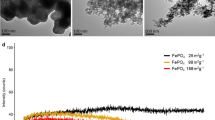Abstract
The objective of the study is to determine the effect of copper (Cu) plus the reducing agent ascorbic acid (AA) on the absorption of non-heme iron (Fe). Experimental study with block design in which each subject was his own control. After signing an informed consent, 14 adult women using an effective method of contraception and negative pregnancy test received 0.5 mg Fe, as ferrous sulfate, alone or with Cu, as copper sulfate, plus ascorbic acid (AA/Cu 2/1 molar ratio) at 4/1; 6/1 and 8/1 Cu/Fe molar ratios as an aqueous solution on days 1, 2, 14, and 15 of the study. Fe absorption was assessed by erythrocyte incorporation of iron radioisotopes 55Fe and 59Fe. Geometric mean (range ± SD) absorption of Fe at 4/1 and 6/1 Cu/Fe molar ratios (and AA/Cu 2/1 molar ratio) and Fe alone was 57.4 % (35.7–92.1 %), 64.2 % (45.8–89.9 %), and 38.8 % (20.4–73.8 %), respectively (ANOVA for repeated measures p < 0.001; post hoc test Scheffé, p < 0.05). This is attributable to the enhancing effect of AA on non-heme Fe absorption; however, Fe absorption at Cu/Fe 8/1 molar ratio was 47.3 % (27.7–80.8) (p = NS compared with Fe alone). It was expected that Fe absorption would have been equal or greater than at 4/1 and 6/1 molar ratios. Copper in the presence of ascorbic acid inhibits non-heme Fe absorption at Cu/Fe 8/1 molar ratio.

Similar content being viewed by others
References
DeMaeyer E, Adiels-Tegman M (1985) The prevalence of anaemia in the world. World Health Stat Q 38:302–316
Mejía-Rodríguez F, Shamah-Levy T, Villalpando S, García-Guerra A, Méndez-Gómez Humarán I (2013) Salud Publica Mex 55:275–284
Zerounian NR, Linder MC (2002) Effects of copper and ceruloplasmin on iron transport in the Caco 2 cell intestinal model. J Nutr Biochem 13:138–148
Arredondo M, Martinez R, Nunez MT, Ruz M, Olivares M (2006) Inhibition of iron and copper uptake by iron, copper and zinc. Biol Res 39:95–102
Tandy S, Williams M, Leggett A, Lopez-Jimenez M, Dedes M, Ramesh B, Srai SK, Sharp P (2000) Nramp2 expression is associated with pH-dependent iron uptake across the apical membrane of human intestinal Caco-2 cells. J Biol Chem 275:1023–1029
Tennant J, Stansfield M, Yamaji S, Srai SK, Sharp P (2002) Effects of copper on the expression of metal transporters in human intestinal Caco-2 cells. FEBS Lett 527:239–244
Olivares M, Pizarro F, López de Romaña D, Ruz M (2010) Acute copper supplementation does not inhibit non-heme iron bioavailability in humans. Biol Trace Elem Res 136:180–186. doi:10.1007/s12011-009-8536-1
Fischer DS, Price DC (1964) A simple serum iron method using the new sensitive chromogen tripyridyls-triazine. Clin Chem 10:21–31
International Anemia Consultative Group (INACG) (1985) Measurement of iron status: a report of the International Anemia Consultative Group. The Nutrition Foundation, Washington, DC
Elin RJ (2004) Reference intervals and laboratory values. In: Goldman L, Ansiello DA (eds) Cecil textbook of medicine, 22nd edn. WB Saunders, Philadelphia, pp 2496–2505
Eakins JD, Brown DA (1966) An improved method for the simultaneous determination of iron-55 and iron-59 in blood by liquid scintillation counting. Int J Appl Radiat Isot 17:191–197
Nadler SB, Hidalgo JU, Bloch T (1962) Prediction of blood volume in normal human adults. Surgery 51:224–232
Bothwell TH, Finch CA (1962) Iron metabolism. Little Brown, Boston
Arredondo M, Núñez MT (2005) Iron and copper metabolism. Mol Aspects Med 26:313–327
Nose Y, Wood LK, Kim BE, Prohaska JR, Fry RS, Spears JW, Thiele DJ (2010) Ctr1 is an apical copper transporter in mammalian intestinal epithelial cells in vivo that is controlled at the level of protein stability. J Biol Chem 285:32385–32392. doi:10.1074/jbc.M110.143826
Wyman S, Simpson RJ, McKie AT, Sharp PA (2008) Dcytb (Cybrd1) functions as both a ferric and a cupric reductase in vitro. FEBS Lett 582:1901–1906. doi:10.1016/j.febslet.2008.05.010
Scheers N (2013) Regulatory effects of Cu, Zn, and Ca on Fe absorption: the intricate play between nutrient transporters. Nutrients 5:957–970. doi:10.3390/nu5030957
Illing AC, Shawki A, Cunningham CL, Mackenzie B (2012) Substrate profile and metal-ion selectivity of human divalent metal-ion transporter-1. J Biol Chem 287:30485–30496. doi:10.1074/jbc.M112.364208
Shawki A, Anthony SR, Nose Y, Engevik MA, Niespodzany EJ, Barrientos T, Ohrvik H, Worrell RT, Thiele DJ, Mackenzie B (2015) Intestinal DMT1 is critical for iron absorption in the mouse but is not required for the absorption of copper or manganese. Am J Physiol Gastrointest Liver Physiol 309:G635–G647. doi:10.1152/ajpgi.00160.2015
Arredondo M, Muñoz P, Mura CV, Nùñez MT (2003) DMT1, a physiologically relevant apical Cu1+ transporter of intestinal cells. Am J Physiol Cell Physiol 284:C1525–C1530
Espinoza A, Le Blanc S, Olivares M, Pizarro F, Ruz M, Arredondo M (2012) Iron, copper, and zinc transport: inhibition of divalent metal transporter 1 (DMT1) and human copper transporter 1 (hCTR1) by shRNA. Biol Trace Elem Res 146:281–286. doi:10.1007/s12011-011-9243-2
Olivares M, Pizarro F, Ruz M (2007) Zinc inhibits nonheme iron bioavailability in humans. Biol Trace Elem Res 117:7–14
Teucher B, Olivares M, Cori H (2004) Enhancers of iron absorption: ascorbic acid and other organic acids. Int J Vitam Nutr Res 74:403–419
Institute of Medicine, Panel on Micronutrients (2001) Dietary reference intakes for vitamin A, vitamin K, arsenic, boron, chromium, copper, iodine, iron, manganese, molybdenum, nickel, silicon, vanadium, and zinc. National Academies Press, Washington, DC
Acknowledgments
The study was supported by grant 1130075 from FONDECYT-Chile.
Author information
Authors and Affiliations
Corresponding author
Rights and permissions
About this article
Cite this article
Olivares, M., Figueroa, C. & Pizarro, F. Acute Copper and Ascorbic Acid Supplementation Inhibits Non-heme Iron Absorption in Humans. Biol Trace Elem Res 172, 315–319 (2016). https://doi.org/10.1007/s12011-015-0605-z
Received:
Accepted:
Published:
Issue Date:
DOI: https://doi.org/10.1007/s12011-015-0605-z




